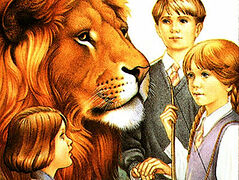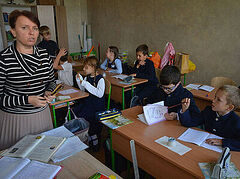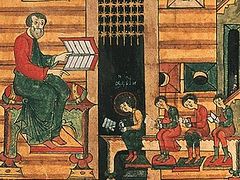 Author and Sunday school students holding the history timeline
Author and Sunday school students holding the history timeline
I have been teaching Sunday school for over fifteen years. While already a teacher at the catechism department of a theological college, I finished the course there. Currently, I mostly teach children aged eight to eleven in our middle level class.
While preschoolers readily come to the right conclusions and emotions when offered an interesting story, the elementary schoolchildren typically need a little more information to achieve this
I used to teach for quite awhile the subject that had the “Church Calendar” as its working title. I talked to children about church feasts, important events from the church life, and the saints. So, if preschoolers easily came to the right conclusions and emotions when entertained with an interesting story, the elementary students needed a little more time and information to achieve this. They ask a lot of profound questions, correlate my story with the historical events they have already heard about, and opine on the actions, background and consequences.
In this regard, I was no longer satisfied with the idea of “telling them something about the saints.” Children are more interested in the context of the time, but when you skip and first tell one story followed by another, you end up with a lot of inconsistencies as a result. For example, in one lesson, we are talking about one monastic saint who lived in the woods of the Russian north in the twelfth century. Then, at the next lesson, we discuss a Roman martyr from the time of Nero, then later on, the life and works of one of the apostles. But the children would constantly distract you by asking the myriad of questions about who reigned, what they wore, and what they rode at the time.
 During the Church history lesson
During the Church history lesson
Over time, I conceived the idea of teaching a course on the universal Church history. Sure, I teach young children and so it is a scary and momentous undertaking, but I wanted to reveal to them a holistic view of the development of Christianity. They also learn about the Old and New Testaments, so history would have complemented their understanding of it, bringing it forward, closer to our time. As for the stories about the saints, they would have logically fitted into this context.
But I needed to arrive at a core concept to build such a course. Young schoolchildren cannot be given lectures—it would kill their interest and motivation. They need something that appeals to their experience, and at the same time, prompts their active participation during the lesson. That’s how the idea of creating a history timeline was born.
Of course, this is not my invention, nor is it anything new; history teachers actively use it in classrooms. But this idea is truly ingenious in its simplicity—displaying the movement of time on paper, placing events one after another.
So, all I needed was:
-
sheets of paper I cut in half lengthwise;
-
a glue stick to connect the cut sheets together into a long scroll;
-
a pencil and a ruler to separate the images from the captions;
-
marker pens so that children could write dates, names, and events;
-
colored printouts—mostly icon reproductions.
I prepared the paper scroll in advance, but we glued the images and added notes at the end of each lesson. The children were assigned roles in advance: someone glued, while another added notes. I allocated about five to seven minutes for this assignment.
There was nothing special about this set of lessons. At first we tried to remember what we learned during the previous lessons, and then, in a free-flow discussion, we talked about a new topic. I made a PowerPoint presentation for each lesson. This is a critical element; no colorful stories sans pictures will ever work for younger schoolchildren. Pictures help them to visualize the epoch and remember the important things.
What were our images? First of all, the images of saints: reproductions of icons, paintings and graphic art. We started our conversations about each saint with an impromptu research: the children looked at the icon and contemplated what they could say about the person on the icon based on his appearance, clothing, and the objects he held in his hands. Over time, we learned to distinguish the holy hierarchs from the monastic saints, and martyrs from the holy rulers—the Equals-to-the-Apostles. At the end of our lessons, we would usually look at our icon and try to analyze it once again.
I also made sure to include photos and drawings of locations of the events we have talked about. The Egyptian desert and its monasteries made a strong impression on the children. It looks so unlike the one in the “Aladdin” cartoon: none of those dunes, only stones, cliffs, and the sky pale from the heat. While we were looking at those photos, we had a conversation about ancient monasticism.
The children showed great interest while viewing pictures of reconstructions of ancient cities, such as Alexandria, Antioch, Cappadocia, Constantinople, and Rome. They studied palaces, hippodromes, temples, baths, figures of people and horses. This way, they saw the lesson material coming to life before their eyes. At the same time, the modern photos of those places reinforced their impressions about them.
At first glance, it may seem that it is necessary to talk only about the saints and important events in the life of the Church, while the rest is a waste of time. They only have one lesson every week, and it’s a short lesson, so why don’t we just speak more about the deeds of the righteous people and miracles? I tried it. It gives poor results.
If you focus on giving the children only the hagiographic material, there is a danger they will begin to perceive it all as fairy tales
If you give children only hagiographic material and talk exclusively about Holy Tradition, there is a danger that they will begin to perceive it all as fairy tales. Many of them do perceive them as fairy tales, especially the ones who rarely or never attend church (we have such children in our Sunday school). What can they think of St. Spyridon of Tremithus holding a brick with fire bursting out of it and water flowing from it? How can we convey to them that this is not a fairy tale, but the saint was one of those who preserved and defended the true Christian faith? This is where historical material comes to our help.
The children enjoyed our lessons. They asked a lot of questions and were happy to learn new things: “We’ve got this icon at home!” “My mother read about this to me!” “I saw it at church!” Or, one of them had been to Turkey and saw the ancient ruins similar to the ones I showed on the pictures. Others watched a cartoon about St. George the Victorious. Someone else is fond of Roman legions and is happy to add to my story. Ancient history comes to life, and visual elements help in this process.
Before each lesson, the children unfold the ribbon of time. They look at the pictures and reread the captions. They compare who is older, St. Nicholas or St. Athanasius of Alexandria? What happened earlier—the Dormition of the Most Holy Mother of God or the First Apostolic Council?
We learned the course of the general history of the Church—from the Descent of the Holy Spirit upon the Apostles to the fight against iconoclasts—in two years. I intentionally took my time and didn’t plan these lessons to last long; it was more important to see how the children reacted, to return to one topic and stay longer on another. It was interesting to experiment—some topics were a hit, while others were taken in poorly and didn’t stir any enthusiasm. For example, the children really enjoyed discussing Tertullian's words, “The blood of the martyrs is the seed of Christianity,” but the conversation about heresies and the fight against them was difficult and way too abstract for them.
Next year, I plan to begin a study of the history of the Russian Church with the same group of students, and create a new timeline. Of course, we didn’t get to the Church schism, but we didn’t need to—it's too complicated for younger schoolchildren. It is enough that we have looked at the first formative stages in Church history, from the Apostles who gathered in the Upper Room, to the Christian capital city of Constantinople. Children will grow bigger and study these topics once again, dwelling more deeply and gaining new information. The major thing is to keep their interest alive.




